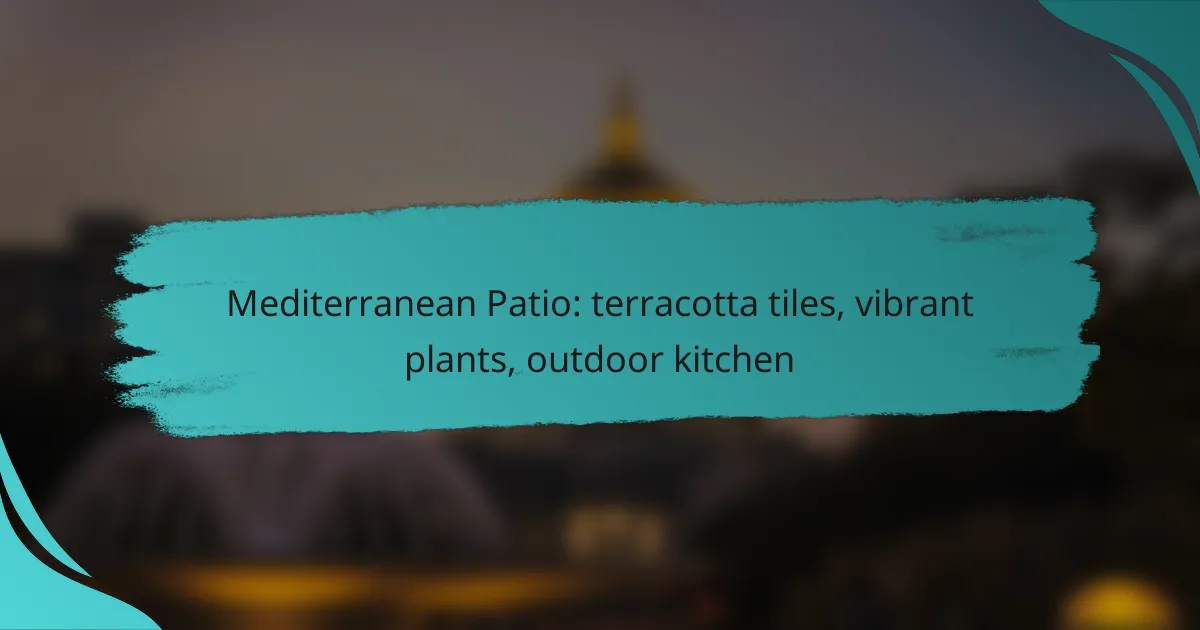Transform your outdoor space into a Mediterranean oasis by incorporating warm terracotta tiles, vibrant plants, and a functional outdoor kitchen. This sun-soaked style emphasizes natural materials and lush greenery, creating an inviting atmosphere perfect for entertaining or relaxing. Embrace the aesthetic appeal and durability of terracotta while selecting drought-resistant plants that thrive in warm, dry conditions to enhance your patio’s charm.

How to create a Mediterranean patio in Australia?
Creating a Mediterranean patio in Australia involves using warm terracotta tiles, vibrant plants, and an outdoor kitchen to capture the essence of this sun-soaked style. Focus on integrating natural materials and lush greenery to enhance the outdoor experience.
Incorporate terracotta tiles
Terracotta tiles are a hallmark of Mediterranean design, providing warmth and a rustic charm. In Australia, choose high-quality, durable tiles that can withstand the climate, ensuring they are suitable for outdoor use.
Consider using a mix of large and small tiles to create interesting patterns. Opt for earthy tones like reds, oranges, and browns to reflect the natural landscape and enhance the overall aesthetic.
Add vibrant plants
Vibrant plants are essential for a Mediterranean patio, bringing life and color to the space. Select drought-resistant varieties such as lavender, rosemary, and bougainvillea, which thrive in Australia’s climate.
Incorporate a mix of potted plants and garden beds to create layers of greenery. Use terracotta pots to maintain the theme and ensure proper drainage for healthy plant growth.
Design an outdoor kitchen
An outdoor kitchen is a key feature of a Mediterranean patio, allowing for alfresco dining and entertaining. Include a grill, countertop space, and a sink for convenience, ensuring materials are weather-resistant.
Consider using stone or brick for the kitchen structure to blend seamlessly with the patio’s overall design. Adding a pergola or shade structure can enhance comfort while cooking and dining outdoors.
Use natural stone elements
Incorporating natural stone elements adds texture and authenticity to your Mediterranean patio. Use stone for pathways, walls, or as accents around the outdoor kitchen to create a cohesive look.
Choose locally sourced stones to reduce environmental impact and ensure durability. Consider options like sandstone or limestone, which can withstand the Australian climate while providing a rustic appeal.
Include shaded areas
Shaded areas are crucial for comfort in a Mediterranean patio, especially in Australia’s warm climate. Use pergolas, umbrellas, or shade sails to create cool spots for relaxation and dining.
Position seating areas strategically under shade structures to maximize comfort during hot days. Incorporate climbing plants on pergolas to enhance the natural feel and provide additional cooling.

What are the benefits of terracotta tiles?
Terracotta tiles offer numerous advantages for Mediterranean patios, including aesthetic appeal, durability, and thermal properties. These clay-based tiles are not only visually striking but also practical for outdoor settings.
Durability and longevity
Terracotta tiles are known for their strength and resilience, making them ideal for outdoor use. They can withstand various weather conditions, from intense sunlight to rain, without significant wear.
When properly sealed, terracotta tiles can last for decades, providing a long-term flooring solution. Regular maintenance, such as cleaning and resealing, can further enhance their lifespan.
Natural thermal regulation
One of the standout features of terracotta tiles is their ability to regulate temperature naturally. They absorb heat during the day and release it at night, helping to maintain a comfortable outdoor environment.
This thermal regulation can reduce the need for additional heating or cooling solutions, making your patio more energy-efficient. In warmer climates, this can lead to cooler outdoor spaces, enhancing comfort during hot summer days.
Variety of colors and styles
Terracotta tiles come in a wide range of colors and styles, allowing for customization to match your patio’s aesthetic. From earthy reds to vibrant oranges, these tiles can complement various design themes.
Additionally, they can be found in different finishes, such as matte or glossy, and patterns, including traditional and contemporary designs. This versatility makes it easy to create a unique outdoor space that reflects your personal style.

How to choose the right plants for a Mediterranean patio?
Choosing the right plants for a Mediterranean patio involves selecting species that thrive in warm, dry conditions while adding vibrant colors and textures. Focus on drought-resistant plants that can withstand the local climate and enhance the outdoor space.
Select drought-resistant species
Drought-resistant plants are essential for a Mediterranean patio, as they require less water and can thrive in hot, sunny environments. Consider options like lavender, rosemary, and succulents, which are not only beautiful but also hardy.
When selecting drought-resistant species, look for native plants that are adapted to your local conditions. These plants often require minimal maintenance and can survive periods of low rainfall, making them ideal for a sustainable patio garden.
Consider local climate conditions
Understanding your local climate is crucial when choosing plants for a Mediterranean patio. Factors such as temperature, humidity, and rainfall patterns will influence which species will flourish in your area.
For instance, if you live in a region with mild winters and hot summers, you can opt for a wider variety of plants. However, in areas with harsher winters, focus on hardy varieties that can withstand colder temperatures while still providing that Mediterranean aesthetic.
Incorporate fragrant herbs
Fragrant herbs not only enhance the sensory experience of a Mediterranean patio but also serve practical purposes, such as culinary uses and pest deterrence. Consider planting basil, thyme, and oregano for both their aroma and utility.
Incorporating these herbs can create a lush, inviting atmosphere while providing fresh ingredients for your outdoor kitchen. Position them in accessible spots so you can easily harvest them for cooking or garnishing dishes.

What features enhance an outdoor kitchen?
An outdoor kitchen is enhanced by features that promote functionality and comfort, making cooking and dining al fresco enjoyable. Key elements include built-in grills and ovens, ample counter space for food preparation, and inviting seating areas for dining.
Built-in grills and ovens
Built-in grills and ovens are essential for any outdoor kitchen, providing a permanent cooking solution that can handle various types of food. Consider options like gas or charcoal grills, which offer different flavor profiles and cooking experiences.
When selecting a grill, look for features such as multiple burners, rotisserie attachments, and side burners for added versatility. Ensure that the grill is constructed from durable materials to withstand outdoor conditions.
Counter space for food preparation
Counter space is crucial for food preparation in an outdoor kitchen, allowing for efficient cooking and serving. Aim for at least 3 to 5 feet of uninterrupted counter space for meal prep, which can be achieved with a combination of countertops and tables.
Materials like granite or stainless steel are popular choices due to their durability and ease of cleaning. Incorporating built-in storage solutions beneath the counter can help keep tools and ingredients organized and accessible.
Seating areas for dining
Seating areas are vital for creating a welcoming atmosphere in an outdoor kitchen. Options range from bar stools at a counter to full dining sets, depending on the space available and the desired ambiance.
Consider the layout to ensure that seating is comfortable and allows for easy movement. Adding cushions or outdoor-friendly fabrics can enhance comfort, while shade solutions like umbrellas or pergolas can make dining more enjoyable during sunny days.

How to maintain a Mediterranean patio?
Maintaining a Mediterranean patio involves regular care for terracotta tiles, vibrant plants, and outdoor kitchen areas. Focus on cleaning, watering, and seasonal adjustments to ensure longevity and aesthetic appeal.
Cleaning terracotta tiles
To keep terracotta tiles looking their best, clean them regularly with a mild detergent and warm water. Avoid harsh chemicals that can damage the surface. For stubborn stains, consider using a mixture of vinegar and water, but test it on a small area first.
It’s advisable to sweep the tiles weekly to remove dirt and debris. Additionally, seal the tiles every few years to protect them from moisture and staining, especially in regions with heavy rainfall.
Caring for vibrant plants
Vibrant plants are essential for a Mediterranean patio. Choose drought-resistant species like lavender, rosemary, and succulents, which thrive in sunny conditions. Water them deeply but infrequently to encourage deep root growth.
Regularly check for pests and diseases, especially during warmer months. Pruning dead or overgrown branches will promote healthier growth and maintain the patio’s aesthetic. Consider using organic fertilizers to enhance plant health without harmful chemicals.
Maintaining the outdoor kitchen
For an outdoor kitchen, regular maintenance is key to functionality and safety. Clean surfaces after each use, and ensure that grills and appliances are free from grease buildup. Use a grill brush to clean grates and check propane tanks or gas lines for leaks periodically.
Protect your outdoor kitchen from the elements by covering appliances when not in use. During colder months, consider winterizing your kitchen by draining water lines and storing utensils indoors to prevent damage from freezing temperatures.
